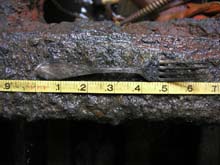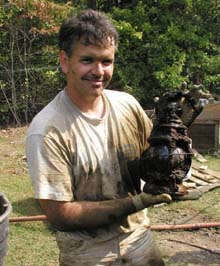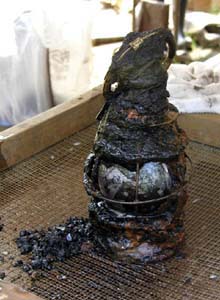
This fork, recovered from the Monitor's turret, bears the initials "SAL" on the handle. Archaeologists suspect the fork could have belonged to Third Assistant Engineer Samuel Augee Lewis, who was lost when the Monitor sank. Click image for larger view and detailed explanation.

Wayne Lusardi, Conservator at The Mariners' Museum, holds up a lantern recovered from the turret. The lantern was probably used to light the interior of the vessel. Click image for larger view and detailed explanation.
Envisioning the Moment
October 15, 2002
Michelle Fox
Education and Communication Coordinator
Monitor National Marine Sanctuary
Excavation of the Monitor’s turret has continued for the past two weeks with some exciting discoveries, among them several pieces of silverware. A small silver spoon was recovered, along with several forks, some of which were monogrammed.
The first fork was located on October 3, 2002, and has an inscription “SAL” and “USN” (United States Navy). Archaeologists speculate that “SAL” could be the initials of Third Assistant Engineer Samuel Augee Lewis, who was lost when the Monitor sank on December 31, 1862. Another fork was inscribed with the letter “G. Frederickson,” which undoubtedly belonged to George Frederickson, an Acting Ensign on the Monitor, who also perished when the ironclad sank.
“With all the preparations we had for the turret excavation and planning for the artifacts we expected to find, the last thing we anticipated was silverware,” said Tane Casserley, NOAA archaeologist. “It’s very exciting to find something so personal to the officers and crew of the Monitor.”
Sanctuary manager John Broadwater added, "Finding silverware and a copper tea kettle in the turret surprised us all. However, we can now speculate that the turret did not immediately separate from the Monitor's hull the night it sank. The galley was located in the hull directly beneath the turret; therefore, the Monitor must have rolled over, dumping galley materials into the turret, before the turret pulled free and sank to the seabed. These are the types of clues that help us reconstruct the events of the sinking, as well as keeping our job interesting!"
Another exciting find was the discovery of a fully intact lantern, complete with its glass globe. A lantern of this type would have been used on the Monitor to light the interior of the vessel. It is uncommon to find a fully intact lantern showing discernible damage after it survived a sinking and lay on the ocean floor for 140 years.

The lantern, shown here, is fully intact. Amazingly, the glass globe survived the sinking and 140 years on the ocean floor. Click image for larger view and detailed explanation.
Read more about what the archeaologists and conservators have found in the turret in this press release (pdf, 52 Kb).
Sign up for the Ocean Explorer E-mail Update List.

































